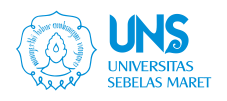ANALISIS PEMENUHAN AIR BERSIH DI DAERAH CEKUNGAN AIR TANAH
Abstract
Population and economic growth have significantly increased human demand for clean water, both in terms of quantity and quality. One way to meet this growing demand is through the extraction of groundwater. This study aims to analyze the fulfilment of clean water needs in the city of Salatiga, which is located within the Rawapening and Salatiga Groundwater Basins. The study emphasizes the importance of sustainable water resource management to ensure future water availability. Using a qualitative descriptive approach, the research was conducted through literature review, field surveys, geoelectrical measurements, hydrological analysis, and the development of a water balance assessment. The results indicate that the available groundwater potential is approximately 5 m³/second, while current utilization is only around 0.069 m³/second. Analysis of domestic and non-domestic water demand reveals an increasing trend through 2028 in line with population growth. The water balance analysis shows seasonal fluctuations, with both surplus and deficit periods. A water deficit occurs during eight months (May to December), with the highest shortfall recorded in October (397 liters/second) and the lowest in May (23 liters/second). To address this shortfall, groundwater resources are proposed as an alternative solution. Given Salatiga's location within a groundwater basin, the city possesses considerable groundwater potential. This presents an opportunity for clean water provision through the development of deep wells, guided by the recommendations from geoelectrical surveys (both in terms of location and potential), to ensure optimal water yield for meeting clean water demands.
Keywords
Full Text:
PDFReferences
Badan Pusat Statistik Kota Salatiga. (2024). Kota Salatiga Dalam Angka. Fatimah, S., Kasim, M., & Akase, N. (2022). Potensi Airtanah Menggunakan Metode Geolistrik Resistivitas di Desa Molingkapoto, Kecamatan Kwandang, Kabupaten Gorontalo Utara, Provinsi Gorontalo. Geosfera: Jurnal Penelitian Geografi, 1(1), 1–9. https://doi.org/10.34312/geojpg.v1i1.14317
Hendrayana, H., Widyastuti, M., Riyanto, I. A., Nuha, A., & Aprimanto, B. (2020). Neraca Airtanah Cekungan Airtanah (CAT) Menoreh dan Wates Kabupaten Kulon Progo. Geomedia, 18(2), 10–29. https://journal.uny.ac.id/index.php/geomedia/index
Juang Openg dan Noni Banunaek, F. (2022). Pemetaan Hidrogeologi Dan Potensi Mata Air Di Desa Fatumonas Dan Binafun, Kecamatan Amfoang Tengah, Kabupaten Kupang, Nusa Tenggara Timur. Jurnal Teknologi, 16(1), 2022.
Kementerian ESDM, Pub. L. No. 2, Kementerian ESDM (2017).
Kodoatie, R. J. (2012). Tata Ruang Air Tanah (1st ed., Vol. 1). Andi Offset.
Lesmana, A., Yoseph CSSSA, B., & Yan Waliana Muda Iskandarsyah, T. (2021). Karakteristik Hidrokimia Air Tanah Pada Bagian Timur Cekungan Air Tanah Bandung-Soreang: Studi Kasus Sebagian Kecamatan Cicalengka Dan Kecamatan Cimanggung, Provinsi Jawa Barat. Padjajaran Geoscience Journal, 5.
Listyani, T., & Putranto, T. T. (2020). Studi Potensi Airtanah pada Cekungan Airtanah (CAT) Banyumudal, Kabupaten Kebumen, Jawa Tengah. 18, 531–544. https://doi.org/10.14710/jil.18.3.531-544
Maria, R., Rusydi, A. F., Lestiana, H., & Wibawa, S. (2018). Hidrogeologi Dan Potensi Cadangan Airtanah Di Dataran Rendah Indramayu. RISET Geologi Dan Pertambangan, 28(2), 181. https://doi.org/10.14203/risetgeotam2018.v28.803
Muzaki, A., Bahar, H., Sapto, D., Yuwanto, H., Adhi, I. T., & Surabaya, T. (2019). Analisis Hidrogeologi Kelurahan Grati Tunon dan Sekitarnya Kecamatan Grati Kabupaten Pasuruan. Seminar Nasional Sains Dan Teknologi Terapan VII 2019, 195.
Putranto, T. T., Hidayat, W. K., & Prayudi, S. D. (2020). Pemetaan Hidrogeologi dan Analisis Geokimia Air Tanah Cekungan Air Tanah (CAT) Kendal. Jurnal Ilmu Lingkungan, 18(2), 305–318. https://doi.org/10.14710/jil.18.2.305-318
Putranto, T. T., Winarno, T., & Susanta, A. P. A. (2020). Risk assessment of groundwater abstraction vulnerability using spatial analysis: Case study at Salatiga Groundwater Basin, Indonesia. Indonesian Journal on Geoscience, 7(2), 215–224. https://doi.org/10.17014/ijog.7.2.215-224
Rifai, M. (2022). Pengelolaan Terhadap Pemanfaatan Air Tanah di Kabupaten Demak. Matriks Teknik Sipil, 10(1), 1. https://doi.org/10.20961/mateksi.v10i1.50094
Rifai, M., & Wahyudi, A. H. (2024). Optimasi Distribusi Air Irigasi Melalui Sistem Golongan (Studi Kasus Daerah Irigasi Rongkong Seluas 27.000 Ha). Jurnal Riset Rekayasa Sipil, 8, 27–36.
Salahuddin, Zahara, S. R., Alvina, S., Nazila, A., & Perwira, I. W. (2024). Identifikasi Akuifer Air Tanah dengan Metode Geolistrik Konfigurasi Schlumberger di Kecamatan Muara Batu. JST (Jurnal Sains Dan Teknologi), 12(3). https://doi.org/10.23887/jstundiksha.v12i3.52677
Serli Birliana H, Darsono, & Legowo, B. (2013). Interpretasi Data Geolistrik untuk Memetakan Potensi Air Tanah dalam Menunjang Pengembangan Data Hidrogeologi di Kabupaten Jombang, Jawa Timur. Jurnal Fisika Dan Aplikasinya, 9.
SPAM Salatiga, Pub. L. No. 25, Pemkot Salatiga (2023).
Sudrajat, Y., Handayani, L., Hananto, N., & Mutaqin, B. W. (2017). Pengukuran Geolistrik Untuk Memetakan Cekungan Airtanah Di Kota Mataram. Prosiding Geoteknologi LIPI, 50. https://doi.org/10.1007/1-4020-3102-5
BBWS Pemali Juana. (2022). Pola Pengelolaan Sumber Daya Air.
Triadi Putranto, T., Khaidar Ali, R., & Aji Bagas Putro, dan. (2019). Studi Kerentanan Airtanah Terhadap Pencemaran dengan Menggunakan Metode Drastic Pada Cekungan Airtanah (CAT) Karanganyar-Boyolali, Provinsi Jawa Tengah. Jurnal Ilmu Lingkungan, 17, 158–171. https://doi.org/10.14710/jil.17.1.158-171
Wicaksono, A. R., Putranto, T., & Setyawan, R. (2019). Pemodelan Hidrogeologi Cekungan Airtanah Samarinda-Bontang. Jurnal Geosains Dan Teknologi, 2, 13–23.
Refbacks
- There are currently no refbacks.








